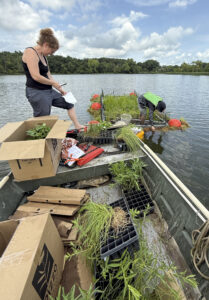Binghamton pharmacy students reveal big differences in local drinking water – Binghamton University

Report on Local Municipal Water Quality and Filtration System Efficacy
A Study in Support of Sustainable Development Goals
A capstone research project conducted by pharmacy students at Binghamton University has provided critical insights into local water quality, directly addressing key United Nations Sustainable Development Goals (SDGs), particularly SDG 6 (Clean Water and Sanitation) and SDG 3 (Good Health and Well-being). The study assessed the quality of municipal water supplies and the effectiveness of common household filtration systems, highlighting disparities that impact community health and sustainability.
Research Objectives and Methodology
The primary objective was to analyze and compare water quality across several municipalities and evaluate the performance of commercial water filters. This aligns with SDG Target 6.1, which aims to achieve universal and equitable access to safe drinking water.
- Initial Scope: The project originally intended to measure pharmaceutical residues in drinking water, a significant concern for SDG 3, which seeks to ensure healthy lives.
- Revised Approach: Due to technical challenges, the research pivoted to examine broader water quality parameters, differences across municipalities, and the impact of filtration on the antioxidant capacity of tea.
- Sample Collection: Tap water samples were collected from four neighboring municipalities:
- Binghamton
- Johnson City
- Vestal
- Endicott
- Filtration Analysis: Three popular household water filters were tested for their effectiveness:
- Culligan
- Brita
- Pure
Key Findings and Relevance to SDGs
Municipal Water Quality Disparities (SDG 6 & SDG 11)
The research uncovered significant variations in water quality among adjacent municipalities, underscoring challenges in achieving equitable access to clean water as mandated by SDG 6 and ensuring sustainable communities (SDG 11).
- Highest Quality: The municipality of Binghamton was found to have the highest quality tap water among the samples tested.
- Lowest Quality: Johnson City’s water supply ranked as the lowest in quality, demonstrating that safe water access can vary dramatically even over short distances.
- Health Implications (SDG 3): While researchers noted that long-term health effects of trace elements are often inconclusive, they identified that certain contents, such as sodium levels, could pose risks for individuals with pre-existing health conditions. This highlights the direct link between water quality and public health outcomes.
Efficacy of Household Filtration Systems (SDG 3 & SDG 12)
The study’s evaluation of water filters provides crucial information for consumers, promoting SDG 12 (Responsible Consumption and Production) by enabling informed choices that safeguard health (SDG 3).
- Most Effective Filter: The Culligan filter demonstrated superior performance in removing particles compared to the other brands tested. This was visually confirmed when filtered water was used to brew tea, with the Culligan sample appearing noticeably lighter.
- Consumer Awareness: Researchers noted a discrepancy between market perception, often driven by advertising (e.g., Brita), and actual product performance. This finding empowers consumers to make evidence-based decisions.
- Antioxidant Retention: A key aspect of the study was the clear difference observed between filters in their ability to retain beneficial antioxidants in tea, further linking filtration choices to health and well-being.
Conclusion: Advancing Community Health and Sustainability
This research project serves as a vital contribution to local public health awareness and the broader mission of the Sustainable Development Goals. By providing empirical data on water quality and filter effectiveness, the study empowers the community with information for making healthier choices. The findings underscore the necessity for continuous monitoring of municipal water systems to ensure equitable access to safe drinking water for all, a cornerstone of SDG 6. Furthermore, the project highlights the importance of scientific research in verifying product claims and fostering responsible consumption patterns, directly supporting the objectives of SDG 3, SDG 11, and SDG 12.
Analysis of Sustainable Development Goals in the Article
1. Which SDGs are addressed or connected to the issues highlighted in the article?
The article highlights issues that are directly and indirectly connected to several Sustainable Development Goals (SDGs). The primary focus on drinking water quality, health implications, and community information links the research to the following SDGs:
-
SDG 3: Good Health and Well-being
The article connects to SDG 3 by investigating potential health impacts of drinking water quality. The students’ initial plan to measure drug residues and their findings on sodium content, which “could pose concerns for people with existing conditions,” directly relate to ensuring healthy lives and promoting well-being.
-
SDG 6: Clean Water and Sanitation
This is the most central SDG addressed. The entire research project is about assessing the quality of municipal drinking water (“clean water”). The study compares water quality across different municipalities (Binghamton, Johnson City, Vestal, Endicott) and evaluates the effectiveness of household filtration systems, which directly pertains to ensuring the availability and sustainable management of water.
-
SDG 11: Sustainable Cities and Communities
The research addresses SDG 11 by examining the quality of a basic municipal service—water supply—within different communities. The finding that “quality can vary even in neighboring towns” highlights disparities in the services that make communities inclusive, safe, and sustainable.
-
SDG 12: Responsible Consumption and Production
The article touches upon SDG 12 by providing information that enables responsible consumption. The testing and comparison of popular water filters (Culligan, Brita, Pure) and sharing these results aim to give “the community information they can use for awareness and future choices,” promoting more informed and sustainable consumer decisions.
2. What specific targets under those SDGs can be identified based on the article’s content?
Based on the article’s content, the following specific SDG targets can be identified:
-
Target 3.9: Substantially reduce the number of deaths and illnesses from hazardous chemicals and water pollution.
The students’ concern about “trace pharmaceuticals in drinking water” and the potential health concerns posed by sodium content directly align with the goal of reducing illnesses from water contamination and hazardous chemicals.
-
Target 6.1: Achieve universal and equitable access to safe and affordable drinking water for all.
The research directly assesses the safety of drinking water. The finding that “Binghamton’s water ranked the best, while Johnson City’s was significantly worse” points to a lack of equitable access to high-quality, safe drinking water, even within a localized region.
-
Target 6.3: Improve water quality by reducing pollution and minimizing release of hazardous chemicals.
The initial intent of the project to “measure drug residues in municipal drinking water” is a direct effort related to monitoring and improving water quality by identifying the presence of hazardous chemicals.
-
Target 12.8: Ensure that people everywhere have the relevant information and awareness for sustainable development and lifestyles.
A key outcome of the research was to provide actionable information to the public. As one student noted, “It’s more about giving the community information they can use for awareness and future choices.” This directly supports the goal of empowering people with the information needed for sustainable lifestyles, such as choosing an effective water filter.
3. Are there any indicators mentioned or implied in the article that can be used to measure progress towards the identified targets?
Yes, the article mentions and implies several qualitative and quantitative indicators that can be used to measure progress:
-
Indicator for Water Quality Variation (Relates to Target 6.1)
The article provides a direct, albeit qualitative, indicator: Comparative ranking of water quality across different municipalities. The statement, “Binghamton ranked the highest in quality, while Johnson City ranked the lowest in quality,” serves as a measure of equitable access to safe water.
-
Indicator for Contaminants (Relates to Targets 3.9 and 6.3)
The article implies an indicator through the parameters the students investigated: The presence and concentration of specific contaminants in drinking water. This includes the “sodium content” they noted and the “drug residues” they initially intended to measure.
-
Indicator for Filtration Effectiveness (Relates to Target 12.8)
The research provides a clear indicator for consumer information: The comparative effectiveness of household water filters in removing particles. The finding that “Culligan was the best out of the three” and was “much more effective… at removing particles” is a direct measure that informs consumer choice. The “noticeably lighter in color” tea brewed with Culligan-filtered water serves as a visible, qualitative indicator of this effectiveness.
4. Table of SDGs, Targets, and Indicators
| SDGs | Targets | Indicators |
|---|---|---|
| SDG 3: Good Health and Well-being | Target 3.9: Substantially reduce illnesses from hazardous chemicals and water pollution. | Presence and concentration of contaminants in drinking water (e.g., sodium content, trace pharmaceuticals). |
| SDG 6: Clean Water and Sanitation | Target 6.1: Achieve universal and equitable access to safe drinking water.
Target 6.3: Improve water quality by reducing pollution. |
Comparative ranking of water quality across different municipalities (e.g., Binghamton vs. Johnson City).
Measurement of drug residues and other pollutants in municipal water supplies. |
| SDG 12: Responsible Consumption and Production | Target 12.8: Ensure people have relevant information and awareness for sustainable lifestyles. | Comparative effectiveness of household filtration systems in removing particles (e.g., performance of Culligan vs. Brita and Pure). |
Source: binghamton.edu
What is Your Reaction?
 Like
0
Like
0
 Dislike
0
Dislike
0
 Love
0
Love
0
 Funny
0
Funny
0
 Angry
0
Angry
0
 Sad
0
Sad
0
 Wow
0
Wow
0
















































:focal(1500,1000)/https://media.globalcitizen.org/a6/9a/a69a4720-d8a1-4715-b596-18738d03c05c/rotary_polio_hero_image.jpg?#)







/countries/sri-lanka/photo-credit---dmc-sri-lanka.tmb-1200v.jpg?sfvrsn=dc298bcc_1#)










.jpg?#)







